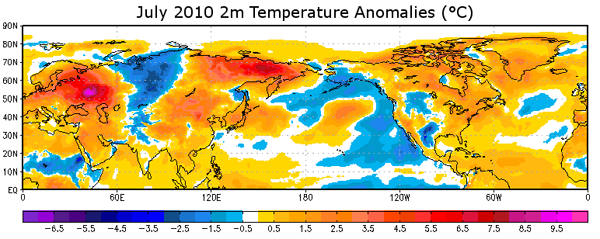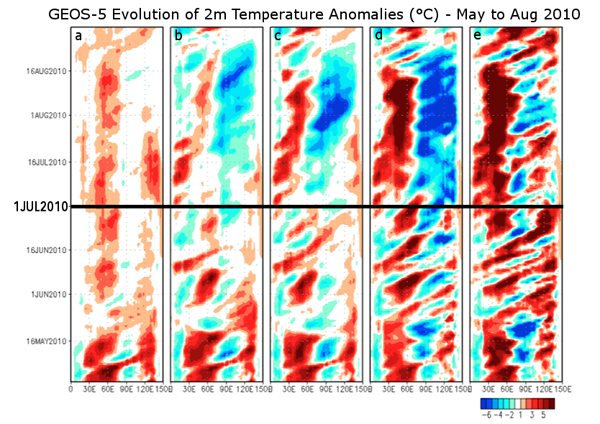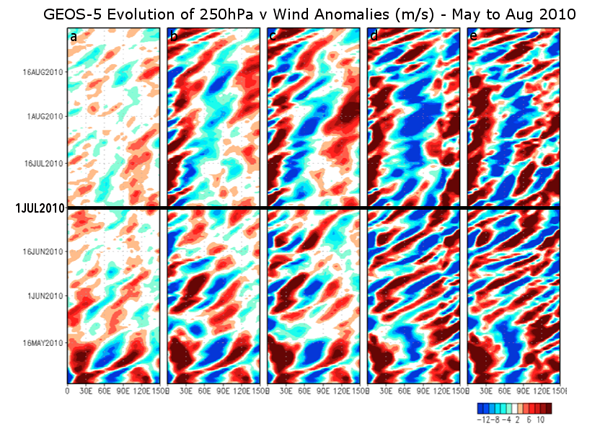Attributing the 2010 Russian Heat Wave
Siegfried Schubert, Hailan Wang, Randy Koster, and Max Suarez
The western Russian heat wave of 2010 took many by surprise. It was the hottest July in western Russia in well over a century, and many Russian cities recorded the hottest temperatures they had ever experienced. When the wave subsided, it left in its wake unimaginable damage: harvests lost, acres upon acres of land scorched, and tens of thousands dead. The severity of the event has led scientists to investigate whether it could have been predicted, and whether the potential for such events has increased with the changing climate.
To answer these types of questions, scientists turn to attribution studies: the multi-step process by which the most likely cause or causes of an anomalous change in the weather or climate can be identified. Observations are analyzed to form a hypothesis, and the validity of that hypothesis is tested with numerical models. Here we use the GMAO's Modern-Era Retrospective analysis for Research and Applications (MERRA) and GEOS-5 to investigate the 2010 event.
MERRA products show the July 2010 Russian heat wave very clearly. Monthly average temperatures were well above climatological "normal" in western Russia for the month, though much of eastern Russia was actually colder than normal at that time. The fact that reanalysis data show a pattern of alternating warm and cold anomalies over Eurasia suggests that an atmospheric wave might have influenced temperatures in the region. Reanalysis of upper level meridional (north-south) winds does indeed indicate that a stationary planetary wave was present over Eurasia in July 2010 (see Figure 1).


Depending on their size and on atmospheric conditions, planetary waves are generally carried by the mean wind or travel counter to it. In certain conditions, however, planetary waves can become stationary and remain locked over an area for an extended period of time. This is known to occur in the winter, but the correlation between surface temperature variability and the leading mode of variability in upper level meridional wind is high over much of Eurasia in the summer months as well, and suggests that planetary wave activity may play a role in warm season temperature anomalies too (Schubert et al., 2011).
These ideas were investigated with GEOS-5 simulations run at 1 degree latitude/longitude horizontal resolution. Several sets of twenty ensemble members were run from May 1, 2010 observed conditions using the GEOS-5 replay capability, which constrains runs to MERRA with varying amounts of freedom. These consist of runs with no constraint (i.e., observed sea surface temperature (SST) provides the sole information of the underlying climate), runs constraining the full atmosphere to MERRA over only parts of the globe, and runs in which the constraint was applied over the whole globe (in that case, just reproducing MERRA). The results (see Figure 2) highlight the importance of the North Atlantic region in forcing the Rossby wave, and are consistent with the idea that transient eddy (weather) variability is the dominant forcing of Northern Hemisphere summer stationary Rossby waves (Schubert et al. 2011). The positive surface air temperature anomalies that develop in the unconstrained case, suggest that SST forcing also played a role in warming (perhaps preconditioning) the continent. The results give confidence to the theory that planetary wave activity is an important factor in summer time surface temperature variability and extremes over Eurasia.


Figure 2b: Same as Figure 2a, but for 250hPa meridional winds. Notice evidence of a Rossby wave and a heat wave developing from 0-60E around July 1, 2010.
Eurasian heat waves develop sporadically in twentieth century GEOS-5 runs forced with observed SST and IPCC greenhouse gas forcings. They seem to be largely the result of natural variability, but it remains to be determined whether greenhouse gas warming may be impacting their frequency and severity (see Dole et al., 2011; Schubert, 2012). Our work continues to investigate the relationship between planetary wave activity and heat waves, and to assess the predictability of such extreme events.
References:
Dole, Randall, M. Hoerling, J. Perlwitz, J. Eischeid, P. Pegion. T. Zhang, X. Quan, D. Murray, 2011: Was there a basis for Anticipating the 2010 Russian heat wave? Geophysical Research Letters, 38, L06702, doi:10.1029/2010GL046582.
Schubert, Siegfried, 2012: On the Role of Reanalysis in Attribution Studies. On the Role of Reanalysis in Attribution Studies. 4th WCRP International Conference on Reanalysis. Silver Spring, MD, World Climate Research Programme. Available online at http://icr4.org/ppts/Schubert.pdf.
Schubert, Siegfried, H. Wang, M. Suarez, 2011: Warm Season Subseasonal Variability and Climate Extremes in the Northern Hemisphere: The Role of Stationary Rossby Waves. J. Climate, 24, 4773-4792, doi: 10.1175/JCLI-D-10-05035.1.

